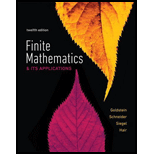
Genetics Traits passed from generation to generation are carried by genes. For a certain type of pea plant, the color of the flower produced by the plant (either red or white) is determined by a pair of genes. Each gene is of one of the types C (dominant gene) or c (recessive gene). Plants for which both genes are of type c (said to have genotype cc) produce white flowers. All other plants—-that is, plants of genotypes CC and Cc—-produce red flowers. When two plants are crossed, the offspring receives one gene from each parent.
Genotype |
Color |
Cc Cc CC |
White Red Red |
(a) Suppose that you cross two pea plants of genotype Cc. What is the probability that the offspring produces white flowers? Red flowers?
(b) Suppose that you have a batch of red-flowering pea plants, of which 60% have genotype Cc and 40% have genotype CC. If you select one of these plants at random and cross it with a white-flowering pea plant, what is the probability that the offspring will produce red flowers?
Want to see the full answer?
Check out a sample textbook solution
Chapter 6 Solutions
Finite Mathematics & Its Applications (12th Edition)
Additional Math Textbook Solutions
Elementary Statistics (13th Edition)
Pathways To Math Literacy (looseleaf)
Calculus: Early Transcendentals (2nd Edition)
Precalculus
Finite Mathematics for Business, Economics, Life Sciences and Social Sciences
- Find the complete set of values of the constant c for which the cubic equation 2x³-3x²-12x + c = 0 has three distinct real solutionsarrow_forwardCan you tell me if I answered and showed my work correctlyarrow_forwardLO 2 -5 -4 -3 -2 0 --1- 2 + -5 Which system is represented in the graph? + LO 5 Xarrow_forward
- > co LO -6 -5 -4 4 do 3 3 2 1 Τ O 1 3 4 5 --6- -CO 6arrow_forward3.12 (B). A horizontal beam AB is 4 m long and of constant flexural rigidity. It is rigidly built-in at the left-hand end A and simply supported on a non-yielding support at the right-hand end B. The beam carries Uniformly distributed vertical loading of 18 kN/m over its whole length, together with a vertical downward load of 10KN at 2.5 m from the end A. Sketch the S.F. and B.M. diagrams for the beam, indicating all main values. Cl. Struct. E.] CS.F. 45,10,376 KN, B.M. 186, +36.15 kNm.7arrow_forwardDraw the isoclines with their direction markers and sketch several solution curves, including the curve satisfying the given initial conditions. 1) y'=x + 2y ; y(0) = 1 and 2) y' = x², y(0)=1arrow_forward
- Qize f(x) = x + 2x2 - 2 x² + 4x²² - Solve the equation using Newton Raphsonarrow_forward-b±√√b2-4ac 2a @4x²-12x+9=0 27 de febrero de 2025 -b±√√b2-4ac 2a ⑥2x²-4x-1=0 a = 4 b=-12 c=9 a = 2 b = 9 c = \ x=-42±√(2-4 (4) (9) 2(4)) X = (12) ±√44)-(360) 2(108) x = ±√ X = =±√√²-4(2) (1) 2() X = ±√ + X = X = + X₁ = = X₁ = X₁ = + X₁ = = =arrow_forwardx/x-2 + 3/x-4arrow_forward
- part barrow_forwardConsider the following model of a population in continuous time. N(t) = rN(t)e¯ß³N(t), r > 0,ẞ> 0. (1) (a) Without solving the equation, determine an upper bound for N(t) in terms of the initial popu- lation No, and the parameters ẞ and r.arrow_forwardQ1: A: Let M and N be two subspace of finite dimension linear space X, show that if M = N then dim M = dim N but the converse need not to be true. B: Let A and B two balanced subsets of a linear space X, show that whether An B and AUB are balanced sets or nor verly A:LeLM be a subset of a linear space X, show that M is a hyperplane of X iff there exists fe X'/[0] and a EF such that M = {x Ex/f(x) = = a}. B:Show that every two norms on finite dimension linear space are equivalent C: Let f be a linear function from a normed space X in to a normed space Y, show that continuous at x, EX iff for any sequence (x) in X converge to x, then the sequence (f(x)) converge to (f(x)) in Y.arrow_forward
- Algebra & Trigonometry with Analytic GeometryAlgebraISBN:9781133382119Author:SwokowskiPublisher:Cengage
 Elementary Linear Algebra (MindTap Course List)AlgebraISBN:9781305658004Author:Ron LarsonPublisher:Cengage Learning
Elementary Linear Algebra (MindTap Course List)AlgebraISBN:9781305658004Author:Ron LarsonPublisher:Cengage Learning

